We live in a body-negative culture, especially for women. 🙁
More at Refinery29

Sacrilege just posted his short film Dear Ulva that features me in drag on the web.
He also posted another short film I helped him with a bit.
You can subscribe to Sacrilege’s youtube channel at http://www.youtube.com/aaronmaclachlan
Written December 22, 2007, Hotel Diganga, Ile-Ife, Nigeria
More catchup–
Then, I went to the main market in Lomé to change my Ghana cedis into CFA used in Togo, Benin, and other francophone West African countries. I managed a not-so-great rate, then tried getting a taxi back to the hotel, which didn’t happen until after I got hot and tired wandering through the market. The guys at the hotel were nice to me and helped me get my bags into a taxi and on my way to the Togo-Benin border.
At each of these borders, it amazed me how the immigration officials were taking bribes to let people pass through despite minor infractions of law or policy. So many of them tried to get me to give money, but I refused. Since I carry a US passport and pay a big visa fee already, I can get away with it.
At least at this border, it was the same shared taxi who waited for us on the Benin side who had dropped us off on the Togo side. I got the ride to Ouidah, then got overcharged for a ride to the Jardin Brasilien, a delightful hotel on the beachfront.
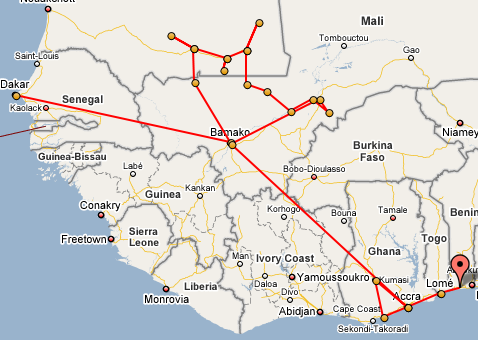
Written December 22, 2007, Hotel Diganga, Ile-Ife, Nigeria
More catchup–
At the Jardin Brasilien, they had a swimming pool filed with sea water.



What a great place to relax from the stress of travel, with the sound of the pounding surf soothing my sleep. I showered in the room before heading over to the pool with the lifeguard came running over before I jumped in to let me know I had to shower. I explained I had already showered, but he was concerned about the sand on my feet getting into the pool. I washed off again and enjoyed a delightful swim just as an elderly fellow was getting out of the pool to go for a walk with a woman I came to find out is his wife. On the way out of the pool, I met a French fellow named Jacques and we agreed to eat dinner together that evening at 8pm. I was so exhausted from travel and a big of digestive trouble that I napped for a few hours before rousing myself for dinner.
Jacques, an older guy from the Mediterranean coast of France, was on a fascinating quest. He served his French military service 40 years ago in Benin, specifically in Parakou in the central to northern part of Benin. While serving, he went to a village where he took some pictures. One guy got upset at him for taking one of the pictures and, after resolving the conflict, Jacques promised to retunr one day to give him a copy of the picture. Jacques had returned to honor his promise after 40 years, but unfortunately the fellow had already died, so Jacques gave the pictures to his family. Jacques searched in another village nearby for a baby who had appeared in one of the old photos. When he found her, the bonded instantly. Jacques ended up asking her what he could do to help her life in the village. She answered that she was trying to set up a nice shop for food and other items, so Jacques financed the operation. He stayed for a couple of weeks, living on pounded yam (igname) every day til the place was set up. I encountered him taking a break to relax from his travel to the village. He had met Isaac (?), the chief lifeguard at the hotel, who asked Jacques if he could help him with some fishing equipment. Jacques agreed. He spent a few days getting the fishing operation set up, impressed by Isaac’s determination, persistence, and courage, for example swimming for nearly an hour after dusk to put the nets out from the shore. The first night they caught nothing, but after placing live instead of dead bait on the hooks, they caught a few man-of-ray’s, including one that delivered two babies on capture. Apparently, people do eat the rays, so Isaac was on his way to town to sell the fish, except for one Jacques and some of the other hotel guests hoped to eat themselves.
My first morning in Ouidah, I met Henri and his girlfriend Natalie who were visiting, biking around, and on vacation from their jobs in Filingué, a few hours drive outside Niamey in Niger. I talked mostly with him, since she wasn’t feeling well with something that sounded exactly like what I had. I found him quite attractive. They ended up inviting me to come visit them after New Year’s in the village, and perhaps I will. He works with cattle breeding and she works in the local radio station.
Off I went to town, on a motorcycle taxi (called taxi-moto or zemi-john) after Jacques’ encouragement to transcend my fears about that mode of transport. On the sandy road, I actually felt safe riding along at a reasonable speed with the sand to cushion any fall. It was only on the cobbled and paved roads that I got anxious.
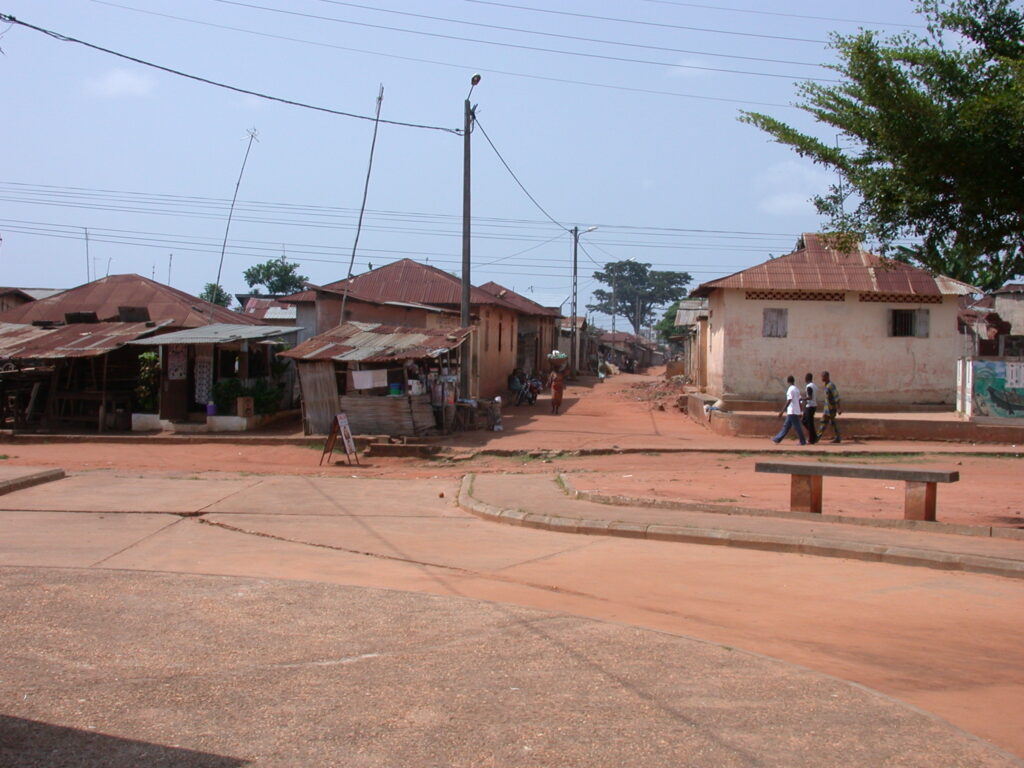
I stopped by the residence of the main chief of Ouidah, Daagbo (see entry of December 11). He asked me to return later that day to snap photos and see the ceremony for the initiates who spent nine months in preparation. Before returning for the ceremony, I visited the local history museum, the Musée d’Histoire de Ouidah, where I met Olivier Coyotte, a Belgian playwright of Turkish origin, and Simon Kind, an attractive Québecois fellow.

I walked to Kpassezoume, or the Kpasse Sacred Forest, which had wonderful sculptures of the various Yoruba divinities, as well as a rare iroko tree said to be the tree King Kpassé turned himself into while fleeing enemies. One finds in the forest the works of contemporary sculptors Cyprien Tokoudagba, Theodore and Calixte Dakpogan, and Simonet Biokou. According to this quote of Dana Rush from an African Arts article of December 22, 2001:
Sometime between 1530 and 1580, Kpasse became the second king of Savi (located nine kilometers north of Ouidah) and founder of Ouidah. When he learned that two jealous enemies were plotting his demise, he alerted his two sons, telling them that although he would never die, he would disappear one day. If it should happen that he did not come out of his room before sunset, his sons were not to open the door but understand that he was already gone. After nine days they would see a specific sign from their father which, once understood, would protect them and their families for generations to come. One day these events did come to pass. Today the sign is still a secret associated with the Kpasse vodun, known only to the direct descendants of the king.
Soon after King Kpasse disappeared, his family living in Savi saw a bird they had never seen before. It led them to the Sacred Forest in Ouidah. Upon entering the sacred grounds of the forest, the bird turned into two growling panthers (male and female). The family was frightened until they heard the soothing voice of the king. He gave them an important message: if at any time they were having problems, they could come to the forest and pray to a specific iroko tree that houses his spirit. The tree was then just a little sprout next to a sacred clay pot. Today, behind the ruins of the old French administrative house in the Sacred Forest, abandoned because the spirits were “too strong” for the French, one finds active shrines, including a clay pot, next to the tree in which Kpasse’s spirit resides (interview with the current King Kpasse, July 19, 1995).











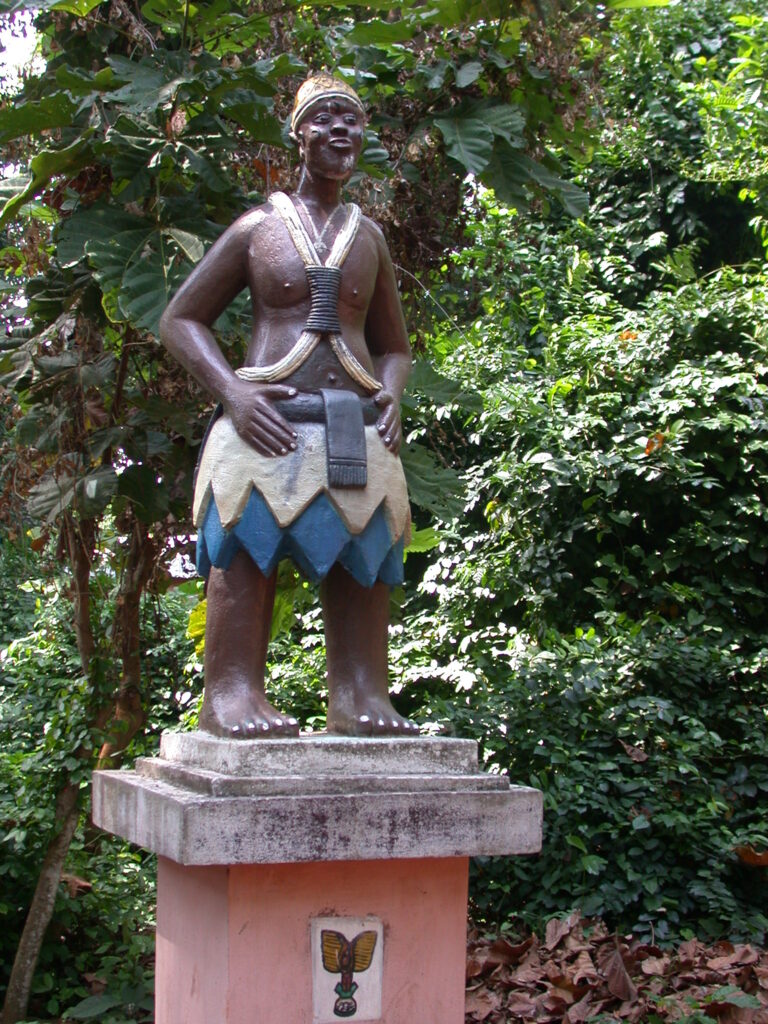








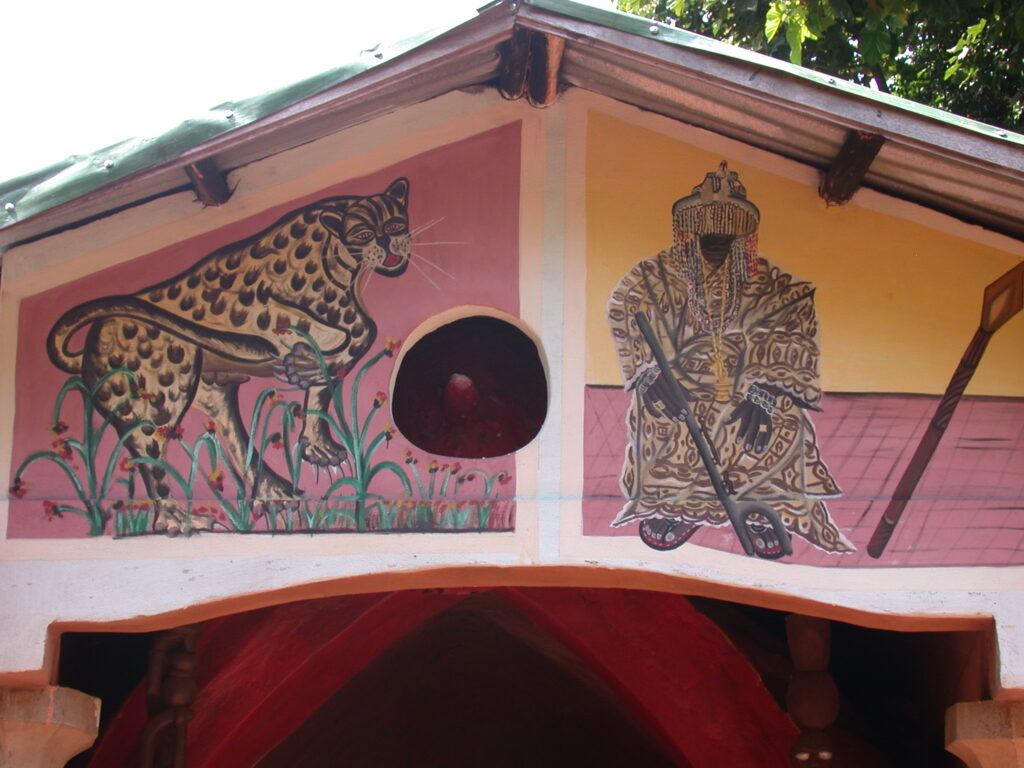


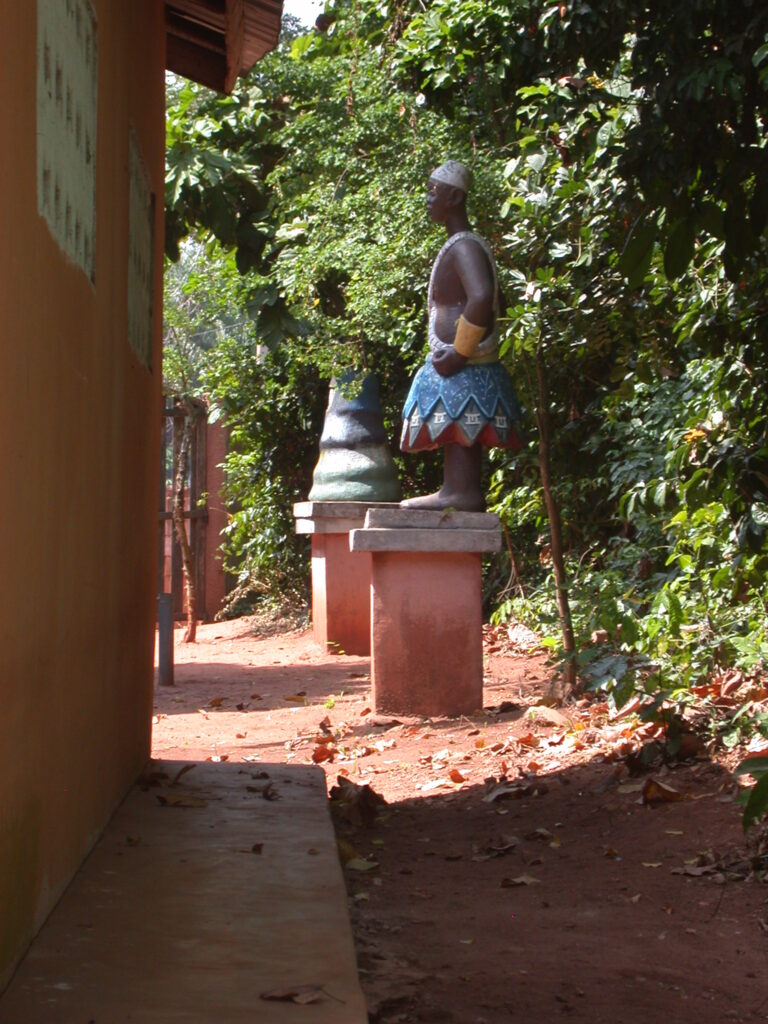






I made a wish by touching the iroko tree said to be King Kpasse and leaving an offering (last picture above).



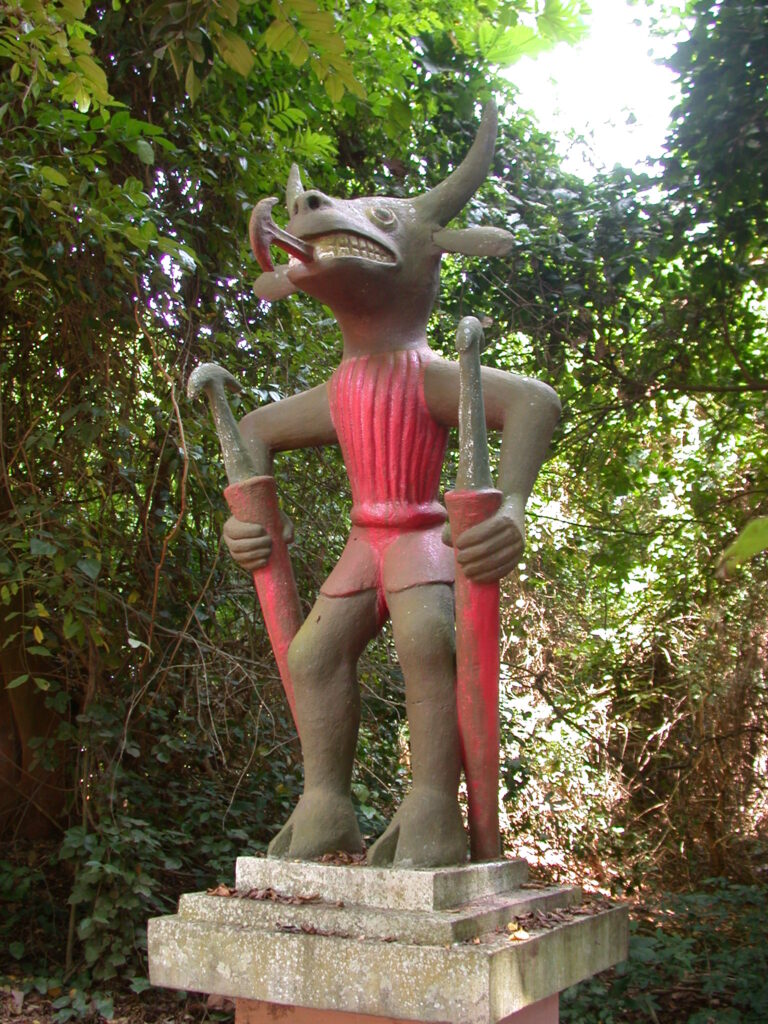








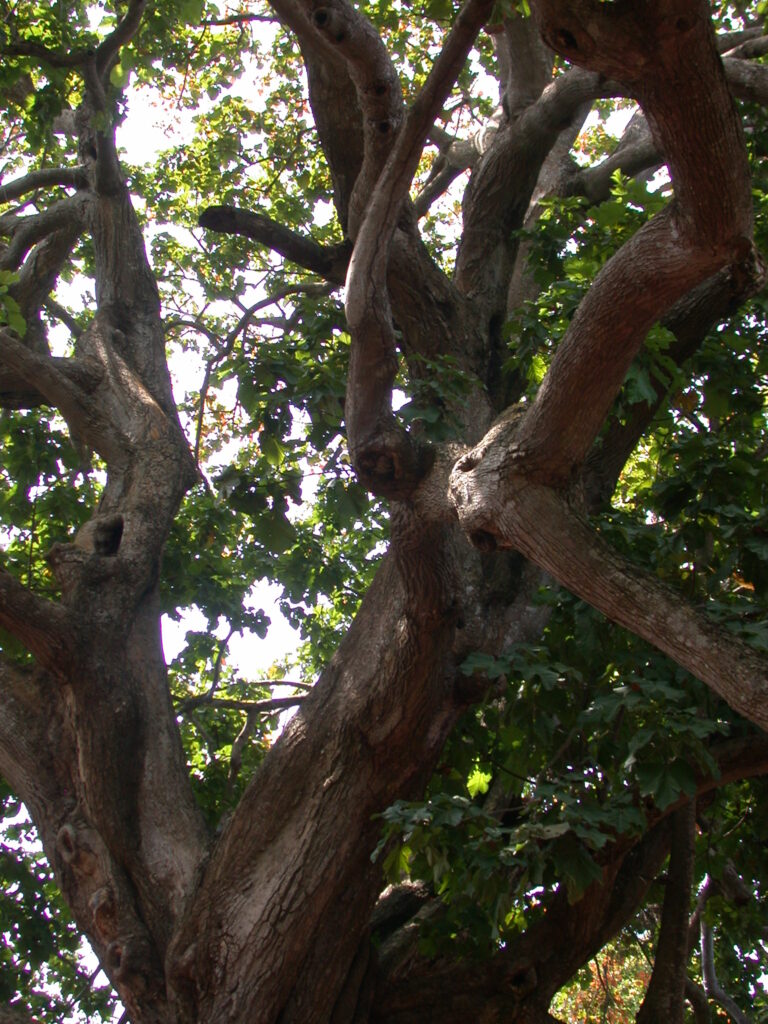

After leaving the sacred forest, I rode a zemi to the python temple where they tried to gouge me for cash to take photos which I fortunately refused because the temple was interesting, but rather small. They had a roundhouse full of pythons who stay inside during the day then go out at night to feed on rodents. Residents of Ouidah respect the pythons and return them to the temple if found on the streets. Every 9(?) years, a ceremony takes place at the temple, the details of which the guide would not really elaborate, somewhat infuriatingly repeating the same stock response over and over while also asking if I had any more questions. You can read more and see photographs of this python temple at Xeni Jardin’s blog.
After the pythons, I walked toward Daagbo’s residence. On the way, I chatted with a few guys hanging out in a telecom shop. I took a picture of this sculpture carved from an old tree to represent the history of Ouidah.



November 4, 2007, Île de Gorée, Dakar, Senegal
When the ferry was ready for us, everyone in the waiting room squeezed through two small exits onto the dock. Then, we crossed over to the ferry with two guys grabbing each passenger to help them across the one foot wide step to get on board. Once on board, the two Germans and I sat on the upper deck. I chose a spot in the shade. In port next to us was a giant container and cargo ship, twelve stories tall. The ferry boat is new, launched in 2006 under the name of Beer. The Germans and I joked quite a bit about that… like, how come no free beer on board? 😉


From the ferry, we had excellent views back to the Dakar harbor and Cape Vert (I think it’s called).


Soon, we reached the open sea with magnificent views of Île de Gorée.


We sailed around the tip of the island where the fortress, now a museum, is located to get a great view of the harbor, beach, and seaside.



The island boasts some wonderful old houses.

Once on land, we paid a tourist tax and walked toward the Maison des Esclaves (Slave House), which was closed for siesta time. On the way to the Maison, we saw this monument to the end of slavery with a man and some children having their photo taken alongside the monument.

We also saw a breadfruit tree with breadfruit hanging from its branches.


We entered a cathedral with some black statues, as well as white ones.


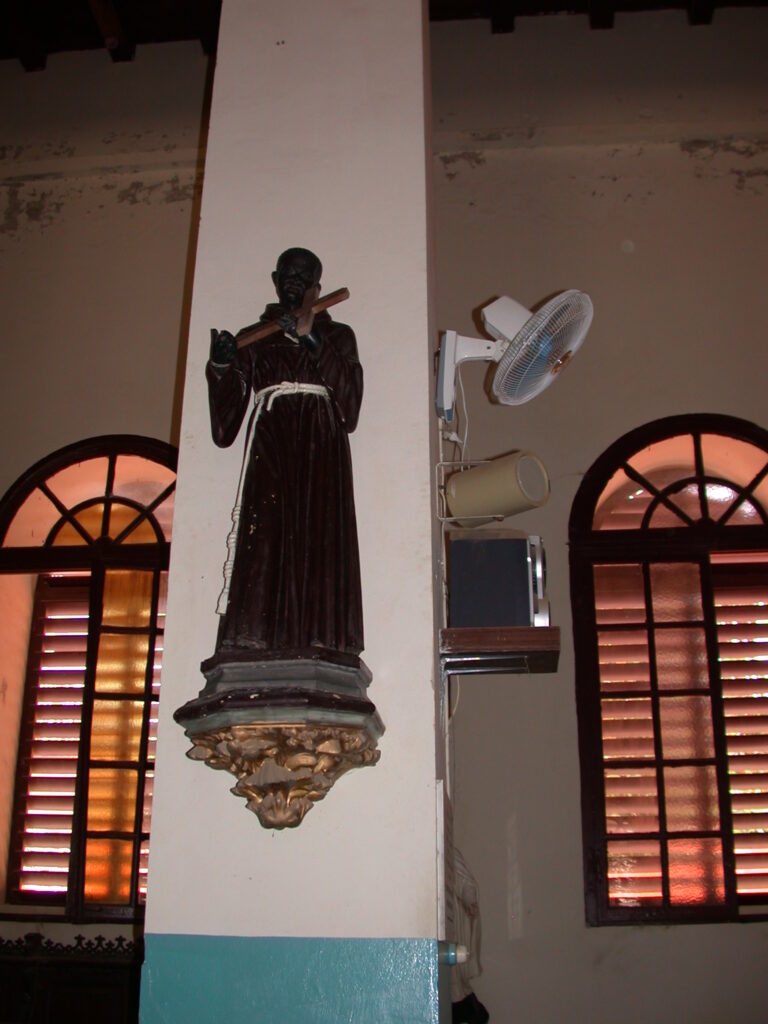
On our way up to a peak where the old cannons are gradually rusting away, we saw many arts and crafts stands and paintings painted by local artists.


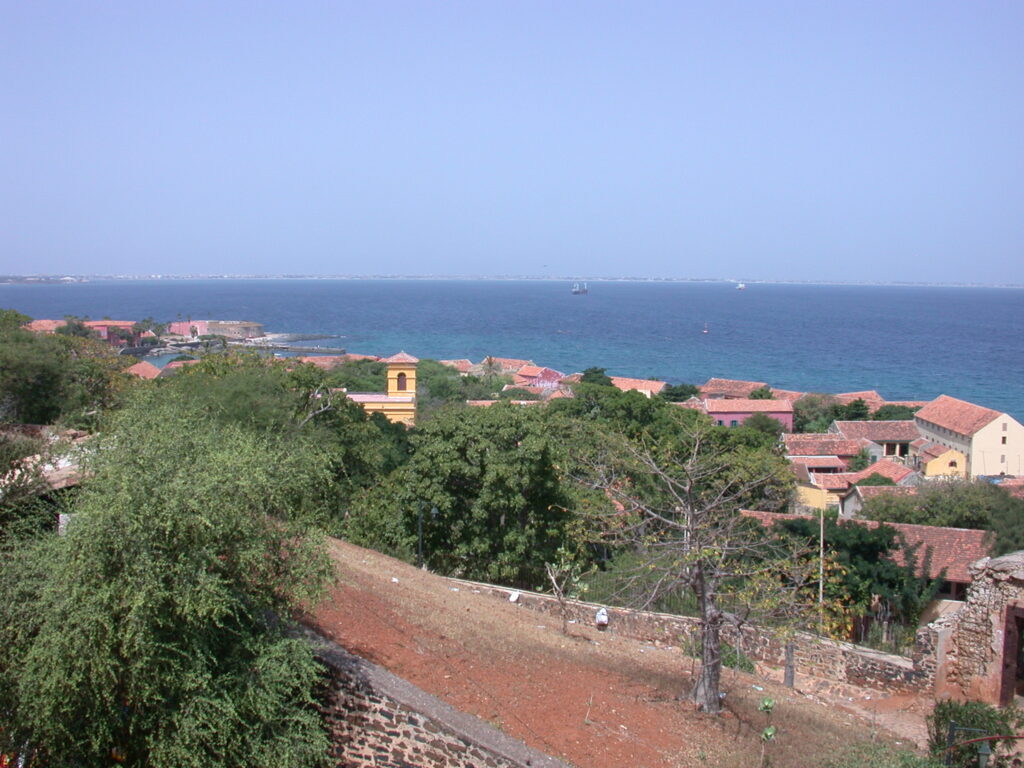
On the way down from the peak, we saw a local soccer game with some guys in real good shape.


We walked over to the port for lunch. A man tried to get us to eat at his restaurant, but I really wanted to eat at the place recommended by the Lonely Planet guidebook. Eventually we escaped his clutches and made our way over to the Ana Saban restaurant.
After lunch, we went to the Musée Historique de l’IFAN on the island.

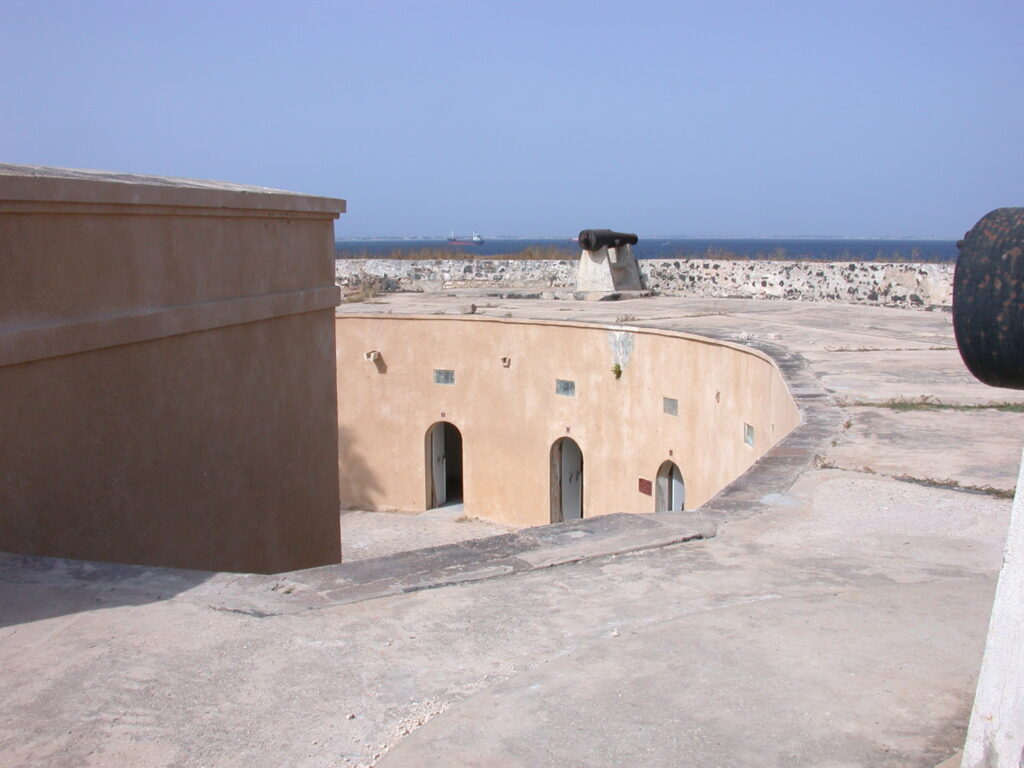

I somehow lost the Germans at the museum, so I walked alone back over past the beach to the Maison des Esclaves, now finished with their siesta break. I started by taking pictures of the “Door of No Return,” which was apparently the last place where slaves bound for the Great Passage across the Atlantic Ocean to the Americas set foot on the African continent.


Here’s what it was like to stand just in front of the door out to where the slave ships used to load their human cargo and the sign currently posted by the Door of No Return.


Inside the Maison des Esclaves, an exhibit explained about the history of the slave trade and showed some of the actual fetters used to bind slaves.

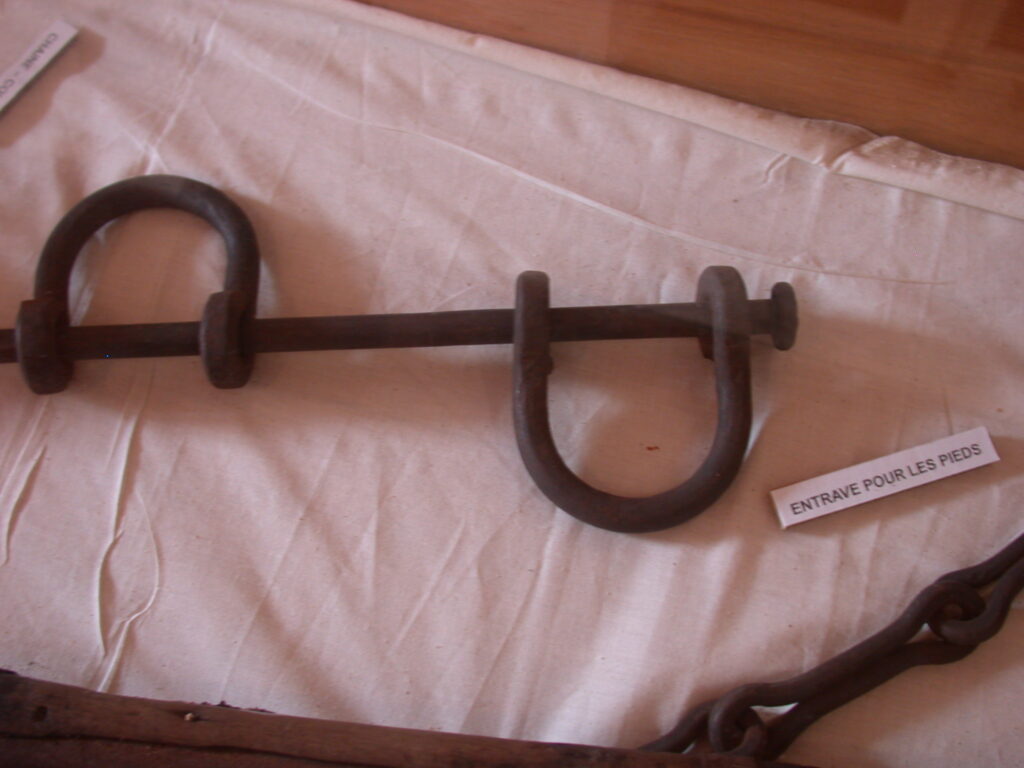
In a small museum office with lots of signs and sayings posted on the walls, there is an elder who must have helped to establish the museum. I went in to thank him for what he has done and he replied that to the contrary he must thank me for coming.
After the disturbing and moving museum, it was a real treat to be able to relax on the beach with locals and people visiting from all over the world. I met a sweet Italian fellow (married) who is working in nutrition in Africa. It was so much fun that the Germans and I had to run for the Beer ferry when it was time to go.




To round out the evening, we dashed to Point des Almadies to see the sunset and eat dinner on the seashore.
I had a great time biking to Boy Beach, which is just south on the coast from the Golden Gate Bridge. I’m so thankful that my body is well enough for me to get out and explore nature and the world.



As I was biking over to the beach, I groaned when I saw a large bank of clouds ahead. As I arrived at the beach, the fog evaporated all at once.



I met a couple of young guys on the beach who were climbing on the cliffs. I asked them about the difficulty of the trail to the bridge and they replied it was easy if I stayed near the water. They thought I was a former teacher of theirs. As I returned from the bridge, I asked them what kind of teacher I was supposed to be, describing my fantasy about being their sex education teacher. They didn’t really think it was funny — oops, I guess they were straight. 😉
Flocks of pelicans flew south over the beach that day.


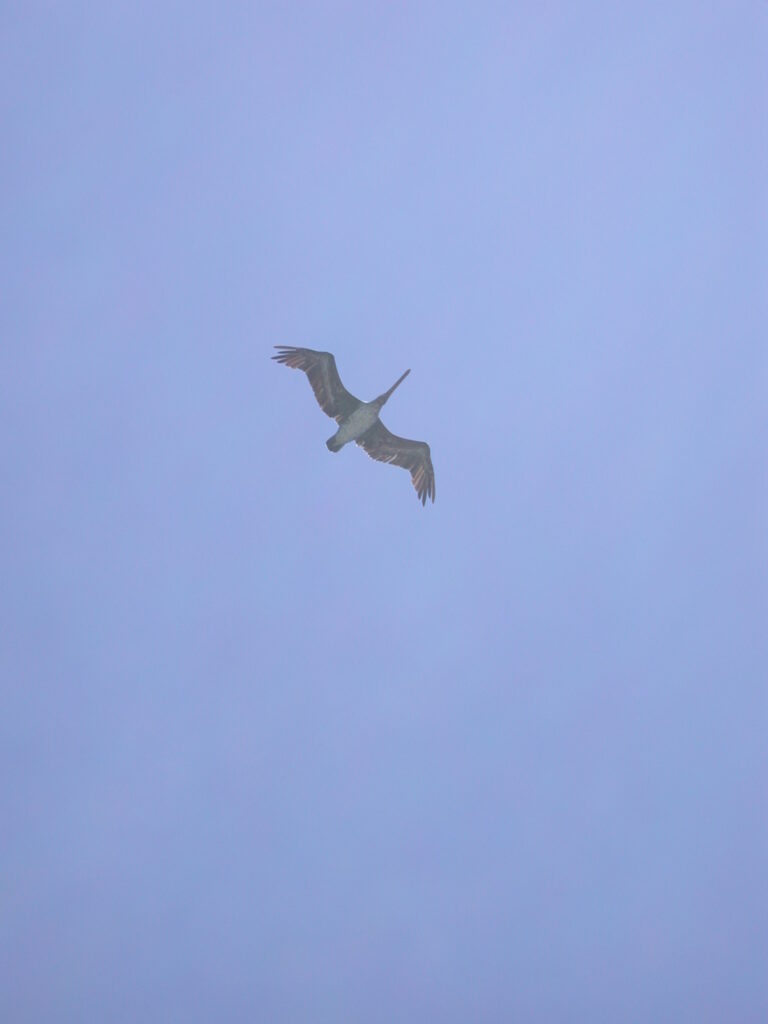
Next I ran across three guys sunbathing together, one of whom was a longhair named Bruce who I gave a card about the Queer Longhair group and mentioned the party at my place for queer longhairs each year on Folsom Fair eve. I sat with them and shared my organic orange mango juice with them. One guy left and I got to know Bruce and Daniel (who joked his name was Moonshine when I told him mine was either Stardust or Will, whichever he prefers to call me). Bruce massaged suntan lotion into Moonshine’s back and then around his buttocks, continuing with a rather penetrating anal massage for quite some time. They were inviting about my participating in some way and I wanted to, but I also felt really shy and uncomfortable. I joined in a little bit, but the mood just wasn’t right. I was more attracted to Moonshine, but he didn’t want to kiss, so the intimacy wasn’t there for me.


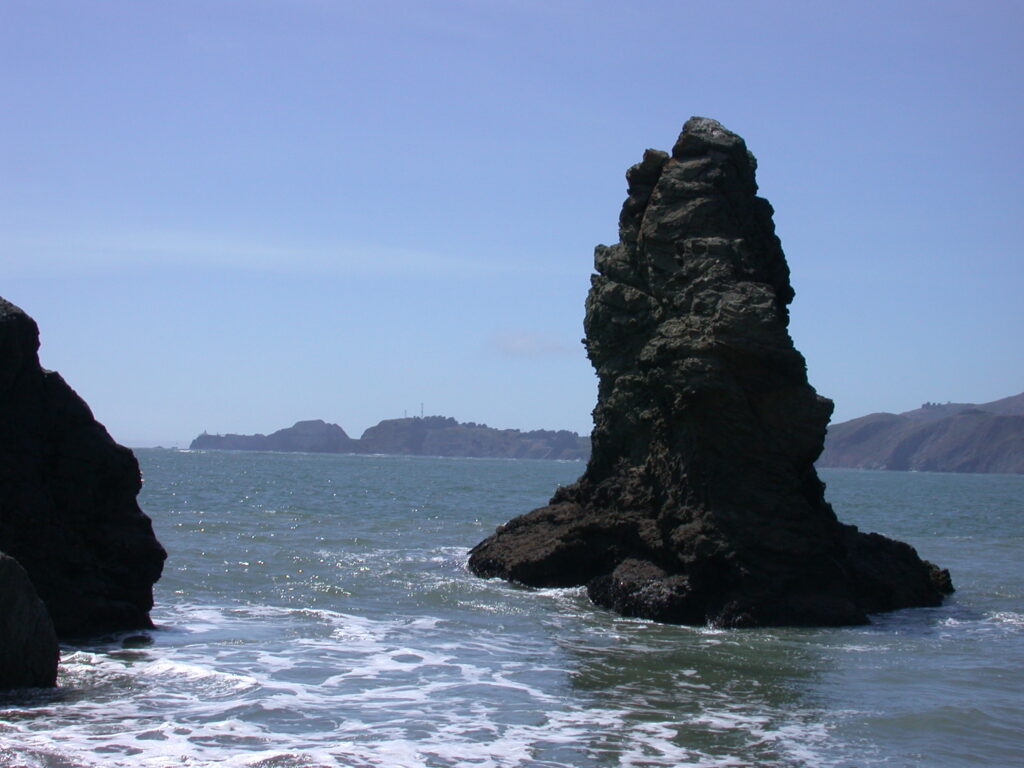
I returned from the beach by biking home. I felt great… it wasn’t a strain to bike even on the hills.
I had an Internet date with Mert after showering. We ate dinner at a new vegan Japanese restaurant called Cha-Ya, which was excellent. I had sea vegetable salad and a dish with veggie pot stickers in hot broth with vegetables. Afterwards, he wanted to go out drinking, so we caught a bus to the Castro and went to The Mix, then to The Bar. I drank mudslides and got quite drunk. He had to catch BART back to the East Bay before midnight, so I rode with him on Muni to the BART stop and continued on to Tubesteak at Aunt Charlie’s on Turk Street. I was on my own with a cool crowd for awhile, then Storm showed up with Jesse and Troy and their friend Will. Somehow, I ended up kissing two different women, one of whom had a moustache painted on her upper lip. I found one guy with two dots painted on each side of his face attractive and gave him my card. On the way home with Storm, we flirted with the taxi driver who let us know he was straight and showed us a picture of his son, now in Denmark with his girlfriend. We urged him to travel to Denmark to be with his family, despite his doubts about the relationship with his girlfriend.